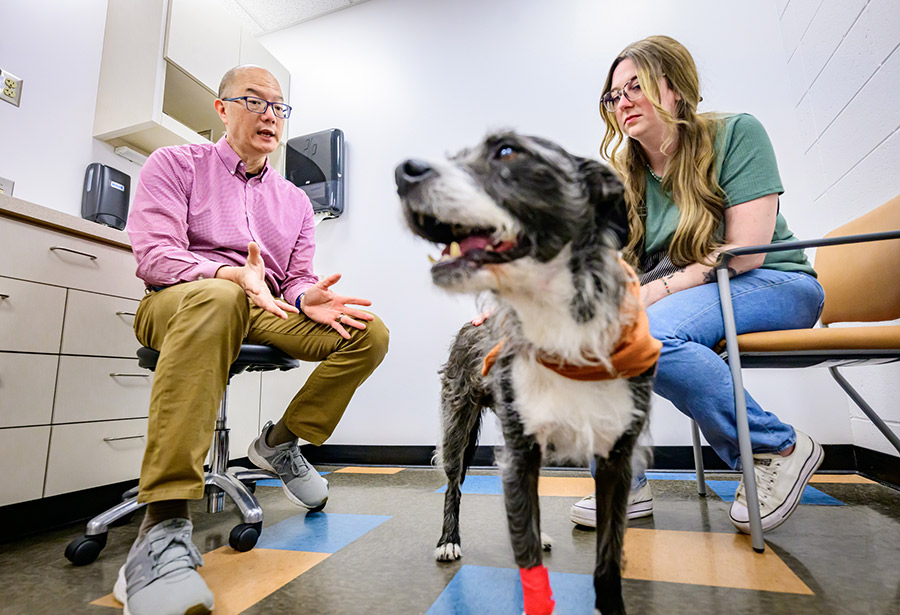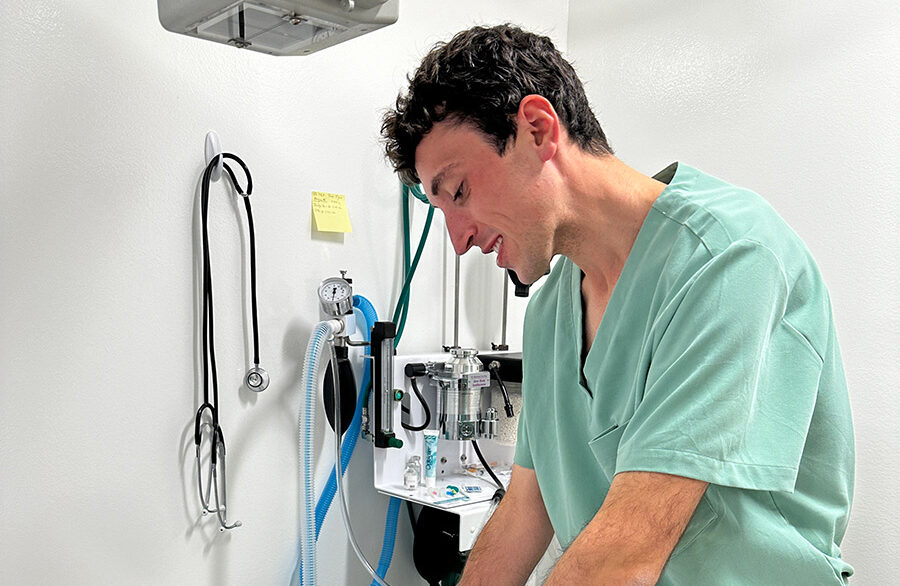$430K Grant Funds Four-Pronged Training
As infectious disease threats arise on new fronts seemingly every day, experts at the University of Illinois are launching programs to train stakeholders in Illinois animal agriculture to respond quickly and efficiently in the event that a foreign animal disease (FAD) breaks in the state. Preparation and coordination are vital to contain such an outbreak, which many believe to be a “not if, but when” inevitability.
Farm Bill-funded Grant
Faculty members at the College of Veterinary Medicine recently received federal funding to deliver this training, designed to build a strong FAD response team that includes veterinarians, producers, governmental officials, and other animal agriculture personnel.
Their grant, entitled “Animal Disease Training and Exercises Across the Veterinary Educational Spectrum,” is funded through the 2018 Farm Bill and administered by the U.S. Department of Agriculture’s (USDA) Animal and Plant Health Inspection Service (APHIS).
The $429,835 grant will encompass four distinct programs to be delivered within the next two years. The programs include a tabletop exercise for responders this fall, a follow-up functional exercise in 2021 to evaluate readiness, training materials for agricultural sector personnel to address educational needs identified through these exercises, and a unique extended program to create an executive-level cohort of producers, veterinarians, and regulatory leaders focused on FAD preparedness for Illinois.
The Illinois grant was announced in January as part of $5.2 million awarded to 26 states through the National Animal Disease Preparedness and Response Program (NADPRP) and funded through the 2018 Farm Bill.
Core Team Delivering Foreign Animal Disease Grant
The four faculty members working on the grant are all veterinarians with extensive experience in the areas of epidemiology, incident management, and interagency coordination. Drs. Gay Miller and Yvette Johnson-Walker are co-principal investigators. Dr. Csaba Varga brings expertise in geographic information systems in relation to disease outbreak and control, and Dr. Will Sander contributes knowledge of the public health sector and agency coordination.
![[miller, johnson-walker, sander, varga]](https://vetmed.illinois.edu/wp-content/uploads/2021/04/news-miller-grantfaculty.jpg)
Dr. Miller’s role in the grant draws upon her decades of research and leadership focused on FAD prevention, preparedness, and response. In 2006-07, during a sabbatical from the University of Illinois, she served as a Science & Technology Policy Fellow, working at APHIS Veterinary Services in Riverdale, Md. There she was riveted by the intense atmosphere surrounding the teams that monitor global foreign animal disease outbreaks to assess the risk to the U.S.
‘A Visceral Feeling’
“Emergency preparedness is so fascinating because you are dealing with dangerous, high-consequence diseases,” she said. “There’s a visceral feeling of worry and excitement. Once you do emergency preparedness work, the attraction never leaves.”
Dr. Miller’s fellowship led to Cooperative Agreements she had with USDA between 2007 and 2012.
Drs. Johnson-Walker and Miller have also partnered on USDA grants related to animal emergency preparedness. Between 2012 and 2016, Dr. Johnson-Walker led the work on emergency training programs designed for personnel at accredited animal exhibitor institutions. That effort, called “Flu at the Zoo” and later “Zoo Ready,” helped staff from zoos and aquariums in 26 states and Washington, D.C., prepare for threats ranging from disease outbreaks to floods, fires, and power outages, an “all-hazards” approach.
Program Specifics
Plans are already under way for the first training exercise funded through the current grant, to be held this September. Using a hypothetical outbreak of Foot and Mouth Disease (FMD) as a model, the tabletop exercise will assess stakeholders’ capabilities to coordinate a response among livestock industry personnel, production medicine veterinarians, academia, and governmental agency personnel.
Representatives from the neighboring states of Indiana, Iowa, Minnesota and Missouri will be invited to participate in the training. FMD is a highly contagious livestock disease that impacts multiple agricultural species and would have devastating economic consequences for Illinois and beyond.
In 2021, a functional exercise will give the participants of the earlier tabletop exercise an opportunity to demonstrate readiness and practice what they learned. It will allow the program providers a chance to evaluate the effectiveness of the training. The assessment will help inform ongoing plans and training materials developed for agricultural sector personnel. (In the photo at the top of the page, emergency responders in PPE [personal protective equipment] prepare for cleaning and disinfection during a training exercise.)
Ongoing training may focus on veterinary students, through either elective courses available through the curriculum at the College of Veterinary Medicine, or perhaps through another delivery system, such as online courses.
Innovative Training Model
Of the four components outlined in the grant, Drs. Miller and Johnson-Walker consider the extended training program to be the most innovative and exciting. It follows an interactive learning model developed at the Illinois College of Veterinary Medicine called the Executive Veterinary Program (EVP). Created in 1993 for swine veterinarians, the model fosters problem-solving skills and a sense of community through close interactions between course participants and world-class instructors.
“We envision our FAD-EVP program to engage a diverse audience of selected livestock industry partners, regulatory players, veterinarians, and leaders in the retail foodservice industry through five 1.5-day modules held over a 10-month period,” said Dr. Miller.
“This approach offers an opportunity for important stakeholder participation across a broad spectrum of our livestock and foods industries,” said Dr. Johnson-Walker. “The long-term and longitudinal nature of the interactions that occur in our FAD-EVP program will enhance response capabilities in Illinois.”
“By the final two modules, we hope that small groups of participants representing different professional disciplines will form teams to address very specific issues related to an FAD response for Illinois,” added Dr. Miller. “It would be very valuable if this project produced white papers that could then be made available to the public.”
Complex Impact of Foreign Animal Disease Outbreaks
Dr. Miller has long studied not only the epidemiological and economic implications for the agricultural industry in the wake of a foreign animal disease outbreak but also strategies for promoting business continuity within the industry while simultaneously improving overall outcomes for consumers and trading partners.
![[depopulating mechanism at a turkey farm]](https://vetmed.illinois.edu/wp-content/uploads/2021/04/news-miller-turkey-depop.jpg)
The impact on trade and other economic facts is not the only fallout from FAD outbreaks, according to Dr. Miller.
“There are important human components of disease outbreaks, even if there is no human health threat from the infectious agent,” she said. “The people affected, either the producers who lose herds and livelihood or the responders who are depopulating herds, have an increased risk of suicide. There are incalculable emotional and financial stresses associated with these outbreaks.”
Dr. Johnson-Walker noted that the training their grant will deliver focusing on response to FAD outbreaks has relevance in a variety of response readiness situations.
“One benefit of our approach to response preparedness and training is that these same skills are applicable in responding to all hazards, including bioterrorism and natural disasters,” she said.

![[scene from food animal disease outbreak training]](https://vetmed.illinois.edu/wp-content/uploads/2021/04/news-miller-fadgrant.jpg)


